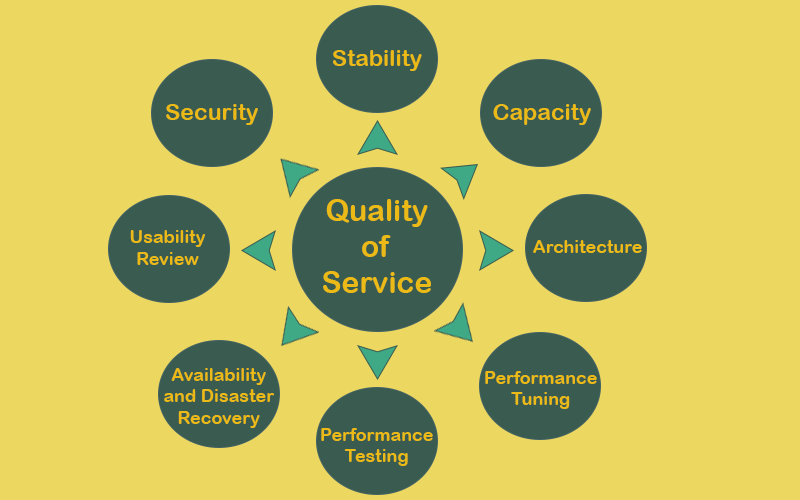
QoS (Quality of Service): Definition, Benefits, and How to Use It
Quality of Service (QoS) knowledge is vital in the modern digital era due to the
Quality of Service (QoS) knowledge is vital in the modern digital era due to the importance of constant and uninterrupted network connectivity and performance. Quality of Service (QoS) refers to a collection of methods and tools that work together to optimize network performance for certain kinds of traffic, making ensuring that critical services have the bandwidth and minimal latency they need. Quality of Service (QoS) is going to be defined, reviewed, and implemented in your network in this post.
What is QoS (Quality of Service)?

Quality of Service (QoS) is the capacity to give priority to specific kinds of network traffic in order to guarantee that essential applications and services continue to function well. It entails controlling and distributing network resources in a way that prioritizes high-priority traffic by minimizing delays, jitter, and packet loss.
Key Components of QoS
- Bandwidth Management: Ensuring sufficient bandwidth is available for high-priority applications.
- Traffic Shaping: Data flow control to avoid network congestion is known as traffic shaping.
- Prioritization: Various forms of traffic (e.g., voice over IP, video streaming, gaming) are given varying degrees of priority during prioritization.
- Latency Reduction: Making Data Transmission Delays as Minimal As Possible.
- Jitter Control: The stabilization of the time variation between the arrivals of data packets is known as jitter control.
Benefits of QoS
Quality of service (QoS) implementation in your network has many benefits that boost performance and user happiness. Here are a few important advantages:
1. Improved Performance for Critical Applications
Critical applications like VoIP (Voice over IP), online gaming, and video conferencing rely on quality of service to guarantee they get the bandwidth and low latency they need to run smoothly. All of a sudden, you won’t have any lag when playing games, watching videos, or making phone conversations.
2. Enhanced User Experience
Quality of Service (QoS) promotes a smooth user experience by allocating resources in a way that minimizes congestion. This is of utmost importance in places like schools, workplaces, and public Wi-Fi hotspots where numerous users are connecting to the network at the same time.
3. Efficient Bandwidth Utilization
By giving priority to critical services and applications, quality of service enables more effective utilization of available bandwidth. So, low-priority traffic can be handled in a manner that doesn’t slow down high-priority apps.
4. Reduced Network Congestion
In order to keep networks from becoming overloaded, traffic shaping and prioritization are implemented. This makes the network more stable and less choppy, especially during heavy traffic periods.
5. Increased Reliability
Quality of Service (QoS) improves network dependability by sending critical data even when demand is high. This is of the utmost importance for companies whose activities depend on consistent and reliable connectivity.
How to Use QoS in Your Network

From determining which apps are mission-critical to setting up network devices, there are various stages to implementing QoS. A thorough tutorial on making good use of QoS is available here:
1. Identify Critical Applications and Services
To begin implementing quality of service, you must first determine which apps and services are critical to your network. In this category you may find cloud computing, online gaming, video conferencing, and voice over IP. You can better distribute resources if you know which applications are more pressing.
2. Classify Network Traffic
The following stage, after determining which applications are crucial, is to categorize your network traffic. Part of this process is classifying the various types of traffic according to their relative importance. One case in point is:
- High Priority: VoIP, video conferencing
- Medium Priority: Streaming video, online gaming
- Low Priority: File downloads, email
3. Configure QoS Policies on Network Devices
Your network components, including switches and routers, can now be configured with quality of service policies thanks to the categorized traffic. Typically, this entails managing bandwidth allotment and establishing rules to prioritize high-priority traffic. Quality of Service setting is available through the administrative interfaces of the majority of current network equipment.
4. Use QoS Tools and Technologies
When it comes to implementing quality of service in your network, there are a number of options to choose from. Among them are:
- Differentiated Services (DiffServ): One way to define and manage network traffic is with Differentiated Services (DiffServ).
- Integrated Services (IntServ): A model that ensures end-to-end quality of service by allocating network resources in advance.
- Priority Queuing: Priority queuing is a method that differentiates between various forms of traffic by giving them varying degrees of importance.
- Traffic Shaping: One way to manage the amount and direction of data transmitted to a network is through traffic shaping.
5. Monitor and Adjust QoS Settings
Quality of Service implementation is not a one-and-done deal; it calls for constant vigilance and course corrections. You may optimize the performance of your quality of service policies by using network monitoring tools to track their performance and making adjustments as needed. To keep your network experience at a high standard, you should check and adjust your QoS settings on a regular basis.
Frequently Asked Questions (FAQ)
1. What is the main purpose of QoS?
Prioritizing network traffic, regulating bandwidth, and lowering latency, jitter, and packet loss are the core tenets of quality of service, which aims to make sure that key applications run well.
2. Can QoS improve my internet speed?
While quality of service does enhance the allocation of existing bandwidth, it does not expand the overall bandwidth available. Quality of Service (QoS) can improve the network experience and the performance of mission-critical applications by giving priority to certain types of traffic.
3. Is QoS necessary for home networks?
If your home network has a lot of competing devices and applications for bandwidth, quality of service (QoS) can be a lifesaver. It can help make sure that even when the network is busy, things like video calls and online games still run well.
4. How does QoS work with VoIP?
To guarantee low latency and little packet loss, VoIP relies on quality of service, which gives voice traffic priority. Essential for efficient communication, this ensures clear and uninterrupted voice calls.
5. Do all routers support QoS?
Even though the features and capabilities of QoS can vary, most current routers do support it. Seek out a router with intuitive configuration choices and strong quality of service settings.
Conclusion
When it comes to monitoring network performance and allocating resources to key applications, QoS (Quality of Service) is a potent tool. If you want your network to be more dependable, efficient, and user-friendly, you should learn about and use quality of service. The control and flexibility needed to meet today’s connection demands are provided by quality of service (QoS), whether you are optimizing your home Wi-Fi or managing a huge enterprise network.
Get the most out of quality of service and have a smooth, high-quality network experience by following this instructions and keeping an eye on your network. Take advantage of quality of service now to make sure your network can manage tomorrow’s problems.
You Can Also Read Here Skills and Qualities of a Successful QA Tester
